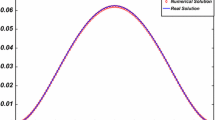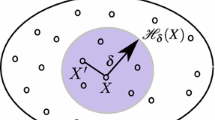Abstract
We develop a family of fast discontinuous Galerkin (DG) finite element methods for a bond-based linear peridynamic (PD) model in one space dimension. More precisely, we develop a preconditioned fast piecewise-constant DG scheme on a geometrically graded locally refined composite mesh which is suited for the scenario in which the jump discontinuity of the displacement field occurs at the one of the nodes in the original uniform partition. We also develop a preconditioned fast piecewise-linear DG scheme on a uniform mesh that has a second-order convergence rate when the jump discontinuity occurs at one of the computational nodes or has a convergence rate of one-half order otherwise. Motivated by these results, we develop a preconditioned fast hybrid DG scheme that is discretized on a locally uniformly refined composite mesh to numerically simulate the PD model where the jump discontinuity of the displacement field occurs inside a computational cell. We use a piecewise-constant DG scheme on a uniform mesh and a piecewise-linear DG scheme on a locally uniformly refined mesh of mesh size \(O(h^2)\), which has an overall convergence rate of O(h). Because of their nonlocal nature, numerical methods for PD models generate dense stiffness matrices which have \(O(N^2)\) memory requirement and \(O(N^3)\) computational complexity, where N is the number of computational nodes. In this paper, we explore the structure of the stiffness matrices to develop three preconditioned fast Krylov subspace iterative solvers for the DG method. Consequently, the methods have significantly reduced computational complexity and memory requirement. Numerical results show the utility of the numerical methods.



Similar content being viewed by others
References
Adams, R.A., Fournier, J.J.F.: Sobolev Spaces. ELsevier, San Diego (2003)
Bobaru, F., Yang, M., Alves, L., Silling, S., Askari, E., Xu, J.: Convergence, adaptive refinement, and scaling in 1D peridynamics. Int. J. Numer. Methods Eng. 77(6), 852–877 (2009)
Chan, R.H., Ng, M.K.: Conjugate gradient methods for Toeplitz systems. SIAM Rev. 38, 427–482 (1996)
Chan, T.: An optimal circulant preconditioner for Toeplitz systems. SIAM J. Sci. Stat. Comput. 9, 766–771 (1988)
Chen, X., Gunzburger, M.: Continuous and discontinuous finite element methods for a peridynamics model of mechanics. Comput. Methods Appl. Mech. Eng. 200, 1237–1250 (2011)
Davis, P.J.: Circulant Matrices. Wiley-Intersciences, New York (1979)
Dayal, K., Bhattacharya, K.: Kinetics of phase transformations in the peridynamic formulation of continuum mechanics. J. Mech. Phys. Solids 54, 1811–1842 (2006)
Deng, W.: Finite element bethod for the space and time fractional Fokker–Planck equation. SIAM J. Numer. Anal. 47, 204–226 (2008)
DeVore, R.A.: Nonlinear approximation. Acta Numer. 7, 51–150 (1998)
Dörfler, W.: A convergent adaptive algorithm for Poissons equation. SIAM J. Numer. Anal. 33, 1106–1124 (1996). https://doi.org/10.1137/0733054
Du, Q., Ju, L., Tian, L., Zhou, K.: A posteriori error analysis of finite element method for linear nonlocal diffusion and peridynamic models. Math. Comput. 82, 1889–1922 (2013)
Du, Q., Tian, L., Zhao, X.: A convergent adaptive finite element algorithm for nonlocal diffusion and peridynamic models. SIAM J. Numer. Anal. 51(2), 1211–1234 (2013)
Emmrich, E., Weckner, O.: The peridynamic equation and its spatial discretisation. Math. Model. Anal. 12, 17–27 (2007)
Gerstle, W., Sau, N., Silling, S.: Peridynamic modeling of concrete structures. Nucl. Eng. Des. 237, 1250–1258 (2007)
Ghajari, M., Iannucci, L., Curtis, P.: A peridynamic material model for the analysis of dynamic crack propagation in orthotropic media. Comput. Methods Appl. Mech. Eng. 276, 431–452 (2014)
Ha, Y.D., Bobaru, F.: Characteristics of dynamic brittle fracture captured with peridynamics. Eng. Fract. Mech. 78, 1156–1168 (2011)
Hackbusch, W.: Hierarchical Matrices: Algorithms and Analysis. Springer, Berlin (2015)
Jia, J., Wang, H.: A preconditioned fast finite volume scheme for a fractional differential equation discretized on a locally refined composite mesh. J. Comput. Phys. 299, 842–862 (2015)
Lai, X., Ren, B., Fan, H., Li, S., Wu, C.T., Regueiro, R.A., Liu, L.: Peridynamics simulations of geomaterial fragmentation by impulse loads. Int. J. Numer. Anal. Meth. Geomech. 39, 1304–1330 (2015)
Li, C., Ding, H.: Higher order finite difference method for the reaction and anomalous-diffusion equation. Appl. Math. Model. 38, 3802–3821 (2014)
Liu, F., Anh, V., Turner, I.: Numerical solution of the space fractional Fokker–Planck equation. J. Comput. Appl. Math. 166, 209–219 (2004)
Lynch, V.E., Carreras, B.A., del-Castillo-Negrete, D., Ferreira-Mejias, K.M., Hicks, H.R.: Numerical methods for the solution of partial differential equations of fractional order. J. Comput. Phys. 192, 406–421 (2003)
Meerschaert, M.M., Tadjeran, C.: Finite difference approximations for fractional advection-dispersion flow equations. J. Comput. Appl. Math. 172, 65–77 (2004)
Mitchell, J.A.: A nonlocal, ordinary, state-based plasticity model for peridynamics. Sandia Report SAND 2011-3166, May 2011
Oterkus, E., Madenci, E., Weckner, O., Silling, S., Bogert, P.: Combined finite element and peridynamic analyses for predicting failure in a stiffened composite curved panel with a central slot. Compos. Struct. 94, 839–850 (2012)
Seleson, P., Du, Q., Parks, M.L.: On the consistency between nearest-neighbor peridynamic discretizations and discretized classical elasticity models. Comput. Methods Appl. Mech. Eng. 311, 698–722 (2016)
Seleson, P., Littlewood, D.: Convergence studies in meshfree peridynamic simulations. Comput. Math. Appl. 71, 2432–2448 (2016)
Seleson, P., Parks, M.L.: On the role of the infuence function in the peridynamic theory. Int. J. Multiscale Comput. Eng. 9, 689–706 (2011)
Silling, S.: Reformulation of elasticity theory for discontinuous and long-range forces. J. Mech. Phys. Solids 48, 175–209 (2000)
Silling, S., Askari, E.: A meshfree method based on the peridynamic model of solid mechanics. Comput. Struct. 83, 1526–1535 (2005)
Silling, S., Epton, M., Wecker, O., Xu, J., Askari, E.: Peridynamic states and constitutive modeling. J. Elast. 88, 151–184 (2007)
Silling, S., Weckner, O., Askari, E., Bobaru, F.: Crack nucleation in a peridynamic solid. Int. J. Fract. 162, 219–227 (2010)
Sun, S., Sundararaghavan, V.: A peridynamic implementation of crystal plasticity. Int. J. Solids Struct. 51, 3350–3360 (2014)
Tian, X., Du, Q.: Analysis and comparison of different approximations to nonlocal diffusion and linear peridynamic equations. SIAM J. Numer. Anal. 51, 3458–3482 (2013)
Tian, H., Wang, H., Wang, W.: An efficient collocation method for a non-local diffusion model. Int. J. Numer. Anal. Model. 10, 815–825 (2013)
Wang, C., Wang, H.: A fast collocation method for a variable-coefficient nonlocal diffusion model. J. Comput. Phys. 330, 114–126 (2017)
Wang, H., Tian, H.: A fast Galerkin method with efficient matrix assembly and storage for a peridynamic model. J. Comput. Phys. 231, 7730–7738 (2012)
Wang, H., Tian, H.: A fast and faithful collocation method with efficient matrix assembly for a two-dimensional nonlocal diffusion model. Comput. Methods Appl. Mech. Eng. 273, 19–36 (2014)
Wang, H., Wang, K., Sircar, T.: A direct \(O(N\log ^2 N)\) finite difference method for fractional diffusion equations. J. Comput. Phys. 229, 8095–8104 (2010)
Xu, F., Gunzburger, M., Burkardt, J., Du, Q.: A multiscale implementation based on adaptive mesh refinement for the nonlocal peridynamics model in one dimension. Multiscale Model. Simul. 14(1), 398–429 (2016)
Xu, F., Gunzburger, M., Burkardt, J.: A multiscale method for nonlocal mechanics and diffusion and for the approximation of discontinuous functions. Comput. Method Appl. Mech. Eng. 307, 117–143 (2016)
Zhang, X., Wang, H.: A fast method for a steady-state bond-based peridynamic model. Comput. Methods Appl. Mech. Eng. 311, 280–303 (2016)
Zhao, M., Cheng, A., Wang, H.: A preconditioned fast Hermite finite element method for space-fractional diffusion equations. Discrete Contin. Dyn. B 22(9), 3529–3545 (2017)
Zhou, K., Du, Q.: Mathematical and numerical analysis of linear peridynamic models with nonlocal boundary condition. SIAM J. Numer. Anal. 48, 1759–1780 (2010)
Acknowledgements
The authors would like to express their sincere thanks to the editor and referees for their very helpful comments and suggestions, which greatly improved the quality of this paper. This work was supported in part by the OSD/ARO MURI Grant W911NF-15-1-0562, by the National Natural Science Foundation of China under Grants 11471194, 11571115, and 91630207, by the National Science Foundation under Grant DMS-1620194, by the National Science and Technology Major Project of China under Grants 2011ZX05052 and 2011ZX05011-004, and by Shandong Provincial Natural Science Foundation, China under Grant ZR2011AM015, and by Taishan Scholars Program of Shandong Province of China.
Author information
Authors and Affiliations
Corresponding authors
Rights and permissions
About this article
Cite this article
Liu, H., Cheng, A. & Wang, H. A Fast Discontinuous Galerkin Method for a Bond-Based Linear Peridynamic Model Discretized on a Locally Refined Composite Mesh. J Sci Comput 76, 913–942 (2018). https://doi.org/10.1007/s10915-018-0645-6
Received:
Revised:
Accepted:
Published:
Issue Date:
DOI: https://doi.org/10.1007/s10915-018-0645-6




